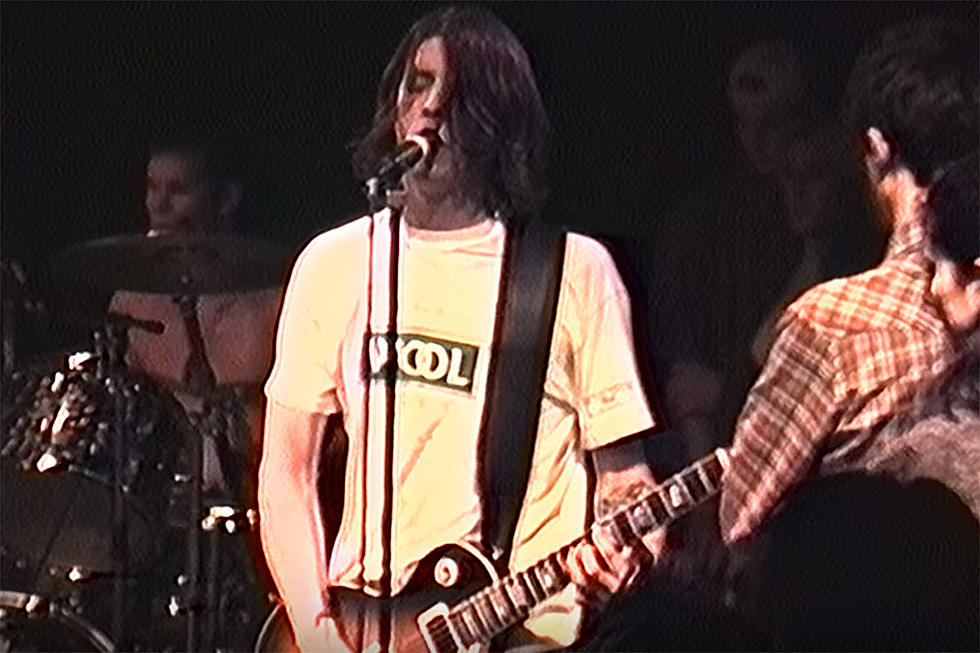
Colin Stetson, ‘New History Warfare Vol. 3: To See More Light’ – Album Review
You may have heard Colin Stetson before. The saxophone auteur is a touring member of the Arcade Fire and Bon Iver, and he’s recorded and performed with the likes of Tom Waits, Anthony Braxton, Fiest, Godspeed You! Black Emperor, David Byrne, TV on the Radio and LCD Soundsystem. Hopefully, you know a few of those names. With the 2011 release of his third LP, ‘New History Warfare Vol. 2: Judges,’ Stetson carved a place out for himself as a solo musician as well, showcasing a viciously unique approach to his trademark bass saxophone, recording sprawling, multi-layered solo tracks in a single go.
‘Judges’ was as much a recording of someone doing aerobic exercise or some kind of religious breathing ritual as it was a musical document. Colin’s mastered a circular breathing technique that allows him to inhale through his nose while supplying a continuous stream of air into his instrument through his mouth. Yeah, this guy is for real. And if you listen to any of Colin’s music, it’s hard to believe he was the only one in the room when it was recorded. He doesn’t use any effects to achieve his hard looping style, and as his press releases proudly state, he gets things done without overdubs -- and in single take to boot.
Stetson uses a complex setup of microphones to capture his saxophone stunt positions. On any given song, he’s working on a handful of levels. You can hear everything from the sub-octaves flooding the room to the valves on his sax working like parts of a rotary machine to Stetson’s voice singing through the saxophone. It’s sort of ridiculous.
But the thing is, you don't need any of the above information in order to hear the genius at work in Colin’s music. The emotional and musical results are somehow more impressive than any technical readout. Stetson’s sound neatly sidesteps any and all genre signifiers while simultaneously working as a mixture of pop, jazz, metal, drone and any other number of experimental offshoots. The scale is enormous. Every track starts small and builds and builds into a shapely mass. And given Stetson’s approach, you feel every single note.
‘New History Warfare Vol. 3: To See More Light’ follows ‘Judges,’ completing a planned trilogy of releases started in 2008, and it’s Colin’s most impressive work to date. The masterful Ben Frost returns to produce, and Justin Vernon of Bon Iver sits in to add vocals to four of the tracks. The results are stunning. Most of ‘To See More Light’’s remaining tracks pick up where ‘Judges’ left off, but not the title track, a 15-plus-minute elephant in the room. Given his aforementioned approach to recording, Stetson should probably be given a Nobel prize for even completing the track, but it also happens to be the most sophisticated and devastating thing he’s ever recorded.
The track opens with Stetson honking into a dark void. He simulates echoes without any effects, blowing softer and softer before jumping into some glimmering, upward arpeggios. Things gain speed, Colin adds in his voice and the melody shifts ever so slightly until we’re hearing a blaring orchestra instead of just a dude. Things settle, Stetson’s voice deepens and some stomping percussion (I’m convinced Stetson used his feet here) slams into heaving, shuddering saxophone doom drones. The track finishes with another breathtaking upward climb before ending on one grinding, belly-flop note. The song is haunting and exotic and brutal. It’s crushingly heavy yet somehow weightlessly aloft.
The Justin Vernon tracks feel like a respite from the otherwise ceaseless instrumental workouts, and they break up the album perfectly. Vernon’s presence is reminiscent of his contribution to 2009’s 'Unmap,' a collaboration with Collections of Colonies of Bees as Volcano Choir. On opener ‘And In Truth,’ Vernon's voice is multi-tracked into an ascentive chorus, which Stetson circles beneath. ‘What Are They Doing In Heaven Today?’ sounds like a riverside spiritual, Stetson’s saxophone like a flock of unwieldy doves overhead. And then there’s ‘Brute,’ which is gleefully out of character for Vernon, as he plays death metal frontman to some sludgy, chaotic sax blasts and double-time percussive taps.
Other standouts ‘High Above A Grey Green Sea,’ ‘Among The Sef,’ and ‘Part of Me Apart From You' show how powerful Stetson’s approach is when everything’s working in tandem. The saxophone perfectly illustrates a rough-hewn landscape before Colin’s voice adds in just the right touch of melody to bring on these sudden and overwhelming emotions. There’s also ‘This Bed Of Shattered Bone,’ perhaps the slowest cut on the record and one of the most gorgeous. Here, Stetson’s wordless “ooohs” punctuate a quick succession of notes before the saxophone wavers hesitantly into a bluesy stillness.
Anyone who’s listened to Stetson will tell you his sound is quick to transcend any notion of “saxophone music,” but ‘To See More Light’ is a testament to how thoroughly that’s true. I can’t think of anything to call this stuff other than “body music.” Stetson plays his horn like it’s an organ, a part of him, and we’re listening to him exercise and manipulate it. It’s at once an almost unbearably intimate bodily expression, yet somehow it’s tearfully beautiful and grand.
More From Diffuser.fm









